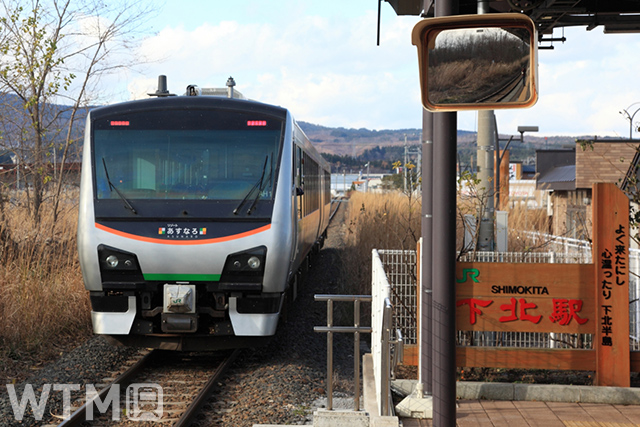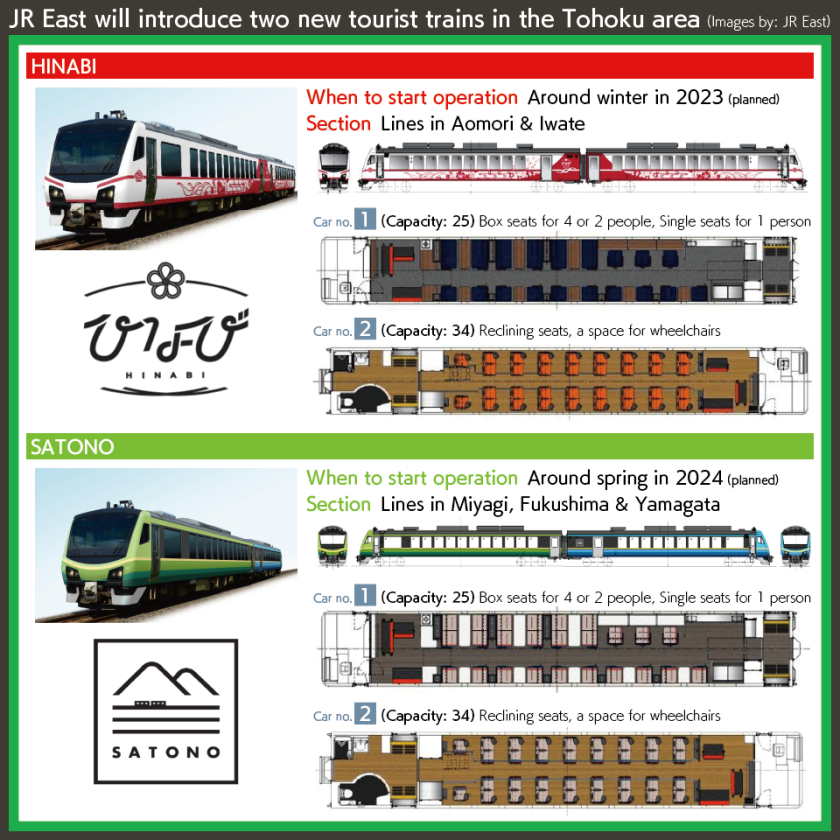JR East will start remodeling the diesel hybrid trains “Resort ASNARO”, which is operated on the Ominato Line, etc., and introduce them to the Tohoku area as two new types of sightseeing trains.
- Red “HINABI” for North Tohoku
- JR East will introduce two new tourist trains in the Tohoku area
- Green and blue “SATONO” for south Tohoku

Red “HINABI” for North Tohoku
“Resort ASUNARO” appeared as sightseeing trains operating on the Tsugaru and Ominato lines in conjunction with the opening of the Tohoku Shinkansen to Shin-Aomori Station in December 2010. Currently, they are running as the special trains “Resort ASUNARO SHIMOKITA” between Hachinohe and Ominato, or “SANRIKU Train MIYAKO” between Morioka and Miyako. The HB-E300 series trains used in them are equipped with a hybrid system that combines a diesel engine, generator, storage battery, and motor, which reduces environmental impact and noise compared to conventional railcars.
“Resort ASUNARO”, which exists in two trains, will be remodeled into two sightseeing trains: “HINABI” belonging to the company’s Morioka branch office and “SATONO” belonging to the Tohoku headquarters. “HINABI” will start operating in each line section of Iwate and Aomori prefectures from around winter 2023, and “SATONO” will start operating mainly in Miyagi, Fukushima and Yamagata prefectures from around spring 2024.
“HINABI” (sounds close to “hinabita” meaning “countrified”) was named from the desire to escape from the busy daily life and have a “warm and relaxing trip” while feeling the nature of northern Tohoku from the train window. The exterior will be painted with a red line on a white background, commonly known as “Morioka color”, which was once common for diesel trains under the jurisdiction of the Morioka branch office. The horizontal line is likened to a “string”, and the “plum knot”, which is a knot of mizuhiki, is put at the top, imagining that it is a train that connects with the region. The mountains in the center of the 2-car train are surrounded by waves, rivers, and patterns of snowflakes, which express the richness of nature.
In addition, the logo mark with flowers and letters connected is an image of “musubi”, which means mutual help and bonds that connect people (Refer to the chart below for details such as exterior images and seating of “HINABI” and “SATONO”).

Green and blue “SATONO” for south Tohoku
On the other hand, “SATONO” (meaning “village’s”) is based on the concept of a train journey where you can slowly and leisurely enjoy the “village of the countryside”, “fragrance of the countryside”, and “local people, food and culture” brought about by the rich climate of Tohoku. Car No. 1 has a green coloring, with young leaves representing the fruits and buds of plants in the Tohoku region, and dark green representing the image of deep mountains. The blue colored Car No. 2 is divided into light blue, which represents the clear and magnificent flow of a river and the wide sky, and dark blue, which is an image of the deep sea.
The operation sections of “SATONO” are set according to the events in each place and the change of seasons. With this train as an opportunity, the company would like to work with the local people to revitalize the entire region and regional revitalization.
“HINABI” and “SATONO” have the same interior layout, and the total seating capacity of the two cars is 59 people, which is more spacious than the current “Resort ASUNARO” (78 people). Car No. 1 of both trains will be remodeled into with a seating arrangement centering on 4-seat and 2-seat box seats that are ideal for group travel. Car No. 2 will be lined with two-seater reclining seats, just like before. Of course, whichever car you ride, you can enjoy the scenery such as the changing seasons from the wide windows.
JR East will announce the specific operation plan, reserved seat fee, on-board service, etc. of the new sightseeing train separately as soon as it is decided.
![[WTM] Railway & Travel News](https://en.wtmnews.net/wp-content/uploads/sites/3/2020/11/cropped-wtm_logo.png)
 [JR Pass] JR East-South Hokkaido Pass | Save time and money exploring eastern Japan and Hokkaido (Ad by KKday)
[JR Pass] JR East-South Hokkaido Pass | Save time and money exploring eastern Japan and Hokkaido (Ad by KKday)